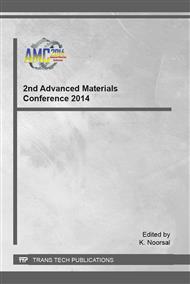[1]
I.M. Krieger, F.M. O'Neill, Diffraction of light by arrays of colloidal spheres, J. Am. Chem. Soc. 90 (12) (1968) 3114–3120.
DOI: 10.1021/ja01014a025
Google Scholar
[2]
R.C. Backus, R.C. Williams, Some uses of uniform sized spherical particles, Journal of Applied Physics. 19 (1948) 1186–1187.
Google Scholar
[3]
C.E. Reese, S.A. Asher, Emulsifier-free emulsion polymerization produces highly charged; monodisperse particles for near infrared photonic crystals, J. Colloid Interface. Sci. 248 (1) (2002)41–46.
DOI: 10.1006/jcis.2001.8193
Google Scholar
[4]
I. Radomska-Galant, T. Basinska, Poly(styrene/α-tert-butoxy-ω-vinylbenzylpolyglycidol) Microspheres for Immunodiagnostics. Principle of a novel latex test based on combined electrophoretic mobility and particle aggregation measurements, Biomacromolecules. 4 (6) ( 2003) 1848–1855.
DOI: 10.1021/bm0342887
Google Scholar
[5]
V.D.G. Gonzalez, L.M. Gugliotta, C.E. Giacomelli, G.R. Meira, Latex of immunodiagnosis for detecting the Chagas disease: II. Chemical coupling of antigen Ag36 onto carboxylated latexes, J. Mater. Sci. Mater. Med. 19 (2) (2008) 789–795.
DOI: 10.1007/s10856-006-0041-x
Google Scholar
[6]
A.V. Pirogov, M.V. Chernova, D.S. Nemtseva, O.A. Shpigun, Sulfonated and sulfoacylated poly(styrene-divinylbenzene) copolymers as packing materials for cation chromatography, Anal. Bioanal. Chem. 376 (5) (2003) 745–752.
DOI: 10.1007/s00216-003-1953-7
Google Scholar
[7]
S.E. Kakabakos, G.P. Evangelatos, D.S. Ithakissios, Immunoadsorption of IgG onto second antibody covalently attached to amino-dylark beads for radioimmunoassays, Clin. Chem. 36 (1990) 3.
DOI: 10.1093/clinchem/36.3.497
Google Scholar
[8]
A. Tuncel E. Piskin, Polystyrene latex particles: preparation and properties, Biomater. Artif. Cells Immobilization Biotechnol. 19 (1) (1991) 229–253.
DOI: 10.3109/10731199109117830
Google Scholar
[9]
J. Meuldijk, M . F Kemmer, A. A H. Drimken, Some aspects of emulsion polymerization process development, Chemie. 134 (1998) 3.
Google Scholar
[10]
F. Caruso J. Wiley & Sons, Colloids and colloid assemblies synthesis, modification, organization, and utilization of colloid particles. Weinheim: Wiley-VCH, (2004).
DOI: 10.1002/3527602100
Google Scholar
[11]
P.A. Lovell, M.S. El-Aasser, Eds., Emulsion polymerization and emulsion polymers, New York: J. Wiley, (1997).
Google Scholar
[12]
H. Warson, R. G. Gilbert, Emulsion polymerization, a mechanistic approach, Academic Press, London, (1995).
Google Scholar


